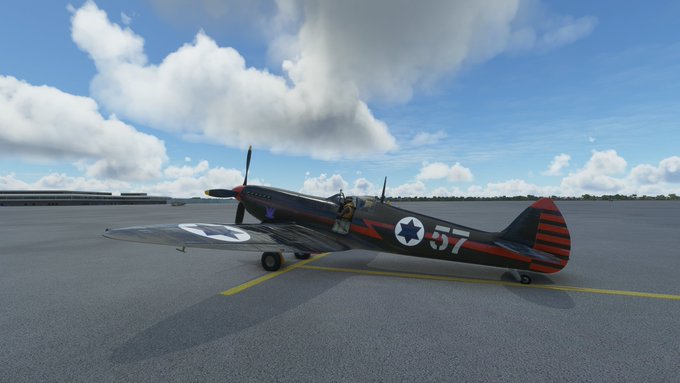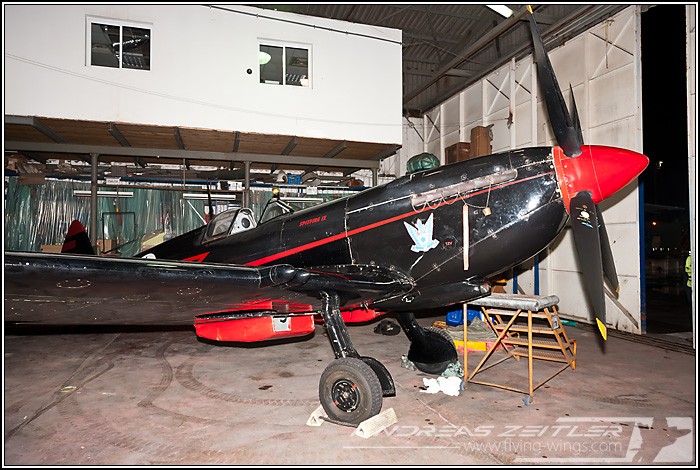December 18, 2022
Today is a two-fer. For my next MSFS trick, I’ll be flying the classic British WW2 fighter, the Spitfire. But not just any Spitfire, mind you, the one-of-a-kind “Black Spit” of the Israeli air force.

I’ll explain the story behind the 57 Black Spit in a second, but first, let’s get this thing started. Starting a Spitfire can be complicated, and it took me a few tries to get it right.

The key is priming. You need to pump what they call the black “wobble ball”, or the right, until the red light below it goes off, in order to create pressure for any fuel to flow. Then you need to pull that gold knob in and out about 5 times to get fuel into the engine to start.

To the left, you can see the throttle, prop handle, and fuel mixture knob, as well as the dials for rudder and elevator trim. You have to change these to certain settings for key stages of flight, in order to keep the Spitfire stable.

Because the thing about the Spitfire is, it’s built to fly fast and agile. That makes it a nightmare on take off and landing, when that becomes “slow and fragile”.

The issue with takeoff isn’t so much keeping it going straight down the runway, though you do need to kick the rudder right to keep it from veering to the left.

No, it’s that just as you start to lift off, the Spitfire gets all squirrely and wants to bank and yaw all over the place until you pick up some speed. The first time I tried to take off, a few days ago, I ended up overcorrecting and nosing straight into the ground.

So now that I’ve taken off from Ben Gurion and am flying over downtown Tel Aviv, I can tell the story of the Black Spit.
Israel was born in 1948, and immediately found itself in a war for survival with all of its Arab neighbors, who refused to recognize its existence. To fight, the Israelis scrambled to get their hands on any surplus weapons they could, anywhere they could find them.]
They built a couple of Spitfires from assorted parts left over by the British. They bought a couple from Czechoslovakia. This one they happened to buy from Italy, in 1949, just after they won their war.

Quick aside: the reason I’m flying a Spitfire here, instead of over the White Cliffs of Dover, is because this is a fairly late model Spitfire Mk.IX. This is not the version that fought the Battle of Britain …

The Mk.IX had a more powerful Merlin engine than the early Spitfires, which enabled them to hold their own against the new German Fw190 fighter. They were mainly used for cross-Channel raids on enemy airbases, to distract the German fighters away from Allied bombers.

In the air, the Spitfire is skittish, but extremely agile. Barrel roles and flying inverted is easy. (You try this with a Cessna 172, the engine will cut out and you may rip the wings right off).

Speaking of which, watch these jokers try it. Listen to the engine nearly cut out, then they go into a kind of upside down dive. Listen to that wind whooshing by. If they aren’t exceeding the “never exceed” speed, they must be close.
Entering a shallow dive to build up speed …

… and pulling the stick all the way back to do a loop.




Here’s what that looks like from the cockpit.

So anyway, after Israel’s war of independence, the Spitfires were used for training the new Israeli air force. Pretty soon, all of them were sold to Burma. All except one.

The Commander of the new Israeli Air Force, Ezer Weizmann, served as a Spitfire pilot in the RAF in WW2. (He later became Israel’s Defense Minister and, eventually, President).

When he was training in Egypt, his instructor painted his own Spitfire black, which Ezer thought was pretty cool. So he kept one of the Spitfires – this one – painted it all black, and used it as his personal aircraft to hop all around Israel.

Now it’s time to land this baby back at Ben Gurion.

So I’ve lowered reduced speed below 160mph, lowered the gear, and brought the speed down further to 120. The problem is, the indicator isn’t lighting up showing my landing gear locked. I don’t know why.

Well, gear locked or not they look down, so I’m coming in. It actually wasn’t as terrible as I thought it would be. But you really have to tap the brakes very gently to slow down gradually. If you stomp them, you’ll flip right over onto your nose.

One tricky thing about the Spitfire is that the gear raise outwards – which means they stick down very close together, near the body. This makes it very easy for the Spitfire to topple over sideways if it gets off balance on landing.

Weizman’s “Black Spit” is still airworthy, btw, and was recently (2012) restored to prime condition.




Not the Spitfire you were expecting, but the Spitfire you didn’t know you needed.

I would have flown this thing over Jerusalem for you, but the terrible truth is that the rendering of the Old City in MSFS right now is TERRIBLE, and no one has fixed it yet. I hope someone does.
Leave a Reply